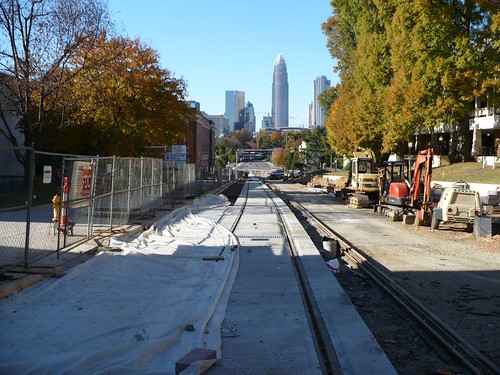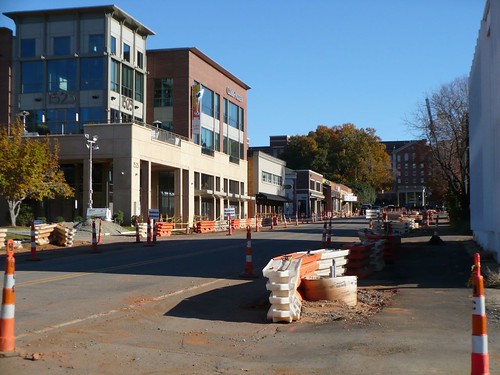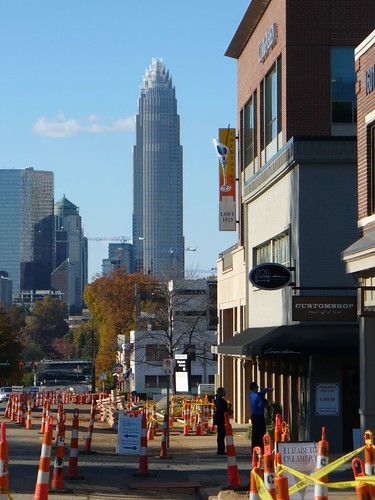Thursday, February 12, 2009
Whither Dubai
Since the workers and money are leaving in droves, I wonder if this means that the Alstom APS light rail system and subway will be put on hold soon.
Elizabeth Avenue
Elizabeth Avenue in Charlotte is getting reconstructed. Instead of ripping it up again later for the streetcar, they are putting in the tracks now. It cost $5 million extra to do it but it's well worth it. Today they are done with the first section of the street, and the businesses are worried because the second section will affect them but they understand that once its done, they'll be better off.










Energy Question
So I've been thinking a lot about the BRT report and comments on the (edited from CCT: Purple Line) in this post. The WRI study states that BRT is better for reductions in GHGs than LRT because LRT comes from dirty sources such as coal. Ok, I'll bite. Here's Greg Fuhs (from WRI) very fair comment at the end of my last post:
I've heard ideas about the power grid benefitting from off peak power usage because the plant was going to run no matter what, but I'm wondering if the GHG's are already being produced, therefor any other emissions such as those from the bus are on top of what already existed from the power plant whether the light rail line was there or not. If this were the case, doesn't that reduce the emissions factor of the LRVs because the emissions are already out there from the coal plant? Does anyone know the answer to this or other ideas?
What we (and MTA) are saying is that by building a medium or high investment BRT system in the corridor, this would reduce GHG emissions from current levels by getting more people out of single vehicles and moving them more efficiently along the corridor than is currently the case. The significant fuel savings from this system would lead to the reduced GHG levels.Now I understand this argument, but I have to dive in a little deeper. I'm wondering if the following thought is true. If you build an electric system, bus or rail, more electricity has to be produced during peak periods where the rail line is more efficient than the buses burning diesel. At the same time, during the off-peak, does the powerplant have to produce extra power or does that energy already exist in the grid.
The reason light rail would increase GHG emissions over No Build is due to the electricity source, which for this region is primarily coal-fired power plants. While people would leave their cars and move more efficiently along the corridor with light rail, the coal plant emissions generated to produce the electricity required for the Purple Line would exceed the emissions savings from getting people out of their cars.
I've heard ideas about the power grid benefitting from off peak power usage because the plant was going to run no matter what, but I'm wondering if the GHG's are already being produced, therefor any other emissions such as those from the bus are on top of what already existed from the power plant whether the light rail line was there or not. If this were the case, doesn't that reduce the emissions factor of the LRVs because the emissions are already out there from the coal plant? Does anyone know the answer to this or other ideas?
Wednesday, February 11, 2009
Signs of the Apocalypse 2
The editor of an automotive magazine (Auto Week) commented that auto makers should start building light rail systems in the United States.
A. They bought designs from existing light rail vendor such as Siemens
B. They allowed local transit agencies to appoint quality control inspectors
C. There is an adopted standard for vehicles agreed upon like in the era of the PCC
I'm sure you all have some ideas too...
One of the shrewdest things the domestic auto industry could do is begin planning to produce light-rail systems.It's nice to know they really think that light rail is competition for automobiles. Apparently they are still worried about losing market share. As much as I like this idea in theory I think it would turn out horrible in practice unless:
...OK, light rail would be competition for cars and trucks. But if it's coming anyway, why not get a piece of the action?
Yes, I know Michael Moore mentioned the same thing a few months ago. But how dumb would it be to ignore a good idea just because it was supported by someone who usually doesn't have a clue
A. They bought designs from existing light rail vendor such as Siemens
B. They allowed local transit agencies to appoint quality control inspectors
C. There is an adopted standard for vehicles agreed upon like in the era of the PCC
I'm sure you all have some ideas too...
Not "The Highway Bill"
I know I've said this before, but it shows where the priorities are for people in the press. They still talk about the 'Highway' bill like that was the only thing the transportation bill funded.
As soon as the stimulus bill is completed, Mica said, the committee is “ready to launch a full effort” to get a highway bill done both on time and with significantly higher investments.We have a lot of work to do. And...OMG BBQ ponies!
Tuesday, February 10, 2009
Railway Robbery?
I don't know about you all, but this seems a bit like a blackmail scheme. It's like we're in Berlusconi's Italy.
It's kind of funny though. After all the problems they've had, what makes them think that making such a claim would even remotely be taken seriously? Maybe they'll get a deal for an American made Sirio.

A firm called AnsaldoBreda says it will relocate its assembly and manufacturing plants from Pittsburg, Calif., and Italy to Los Angeles if -- and it's a big if -- the MTA agrees to buy 100 rail cars from the firm for more than $300 million.This is the same firm that built Muni's and Boston's LRVs. I don't think the LA versions are bad looking, but they are too heavy making them energy hogs and have continued to be a problem in the maintenance department. Perhaps an all in move to Southern California and a change in management would to the company good. Though it doesn't look like that is going to happen. Why would they do that when they should just be expanding thier Pittsburg digs.
It's kind of funny though. After all the problems they've had, what makes them think that making such a claim would even remotely be taken seriously? Maybe they'll get a deal for an American made Sirio.
Sprawl Is Dead! Long Live Sprawl!
What does sprawl mean anymore to anyone? In one day President Obama discusses how important it is to build an interchange and how sprawl is dead. Are those two reconcilable? Only if we define what sprawl is and how it's created. Some on the other side consider streetcar suburbs from the end of the 19th century and early 20th century to be sprawl. They would consider the the Roman Empire to be sprawl.
But we seem to forget that those neighborhoods were made for walking, and recent studies have suggested that the interconnected road networks built by streetcars and before are safer than those built just for cars. This isn't just an issue of the environment, its an issue of public health and safety. But does that lead to a simple definition of the detrimental effects of sprawl?
So what is sprawl? Is it like Larry Flint's magazines? Do you know it when you see it? To my own understanding, sprawl is development that acts as a leach, taking tax base away from central cities and spending it sooner than it can be raised. It doesn't necessarily mean low density alone because that is a part of the market, just not 80% of it. The Fresno Bee also had a story about a study done on farmland preservation in California's central valley. We're losing land fast to endless unsustainable development. But how do we get to sustainable? What is the goal there? 0% net energy usage? Then there is this dependence on oil thing.
 Sinn-Frei via Steven B.
Sinn-Frei via Steven B.
But is it sprawl if your house is close to your job, even if you live out the suburbs? I've tried to think of what it is and what it isn't, but I can't seem to pin it down. So if we can't define it, how do we kill it?
But we seem to forget that those neighborhoods were made for walking, and recent studies have suggested that the interconnected road networks built by streetcars and before are safer than those built just for cars. This isn't just an issue of the environment, its an issue of public health and safety. But does that lead to a simple definition of the detrimental effects of sprawl?
So what is sprawl? Is it like Larry Flint's magazines? Do you know it when you see it? To my own understanding, sprawl is development that acts as a leach, taking tax base away from central cities and spending it sooner than it can be raised. It doesn't necessarily mean low density alone because that is a part of the market, just not 80% of it. The Fresno Bee also had a story about a study done on farmland preservation in California's central valley. We're losing land fast to endless unsustainable development. But how do we get to sustainable? What is the goal there? 0% net energy usage? Then there is this dependence on oil thing.
 Sinn-Frei via Steven B.
Sinn-Frei via Steven B.But is it sprawl if your house is close to your job, even if you live out the suburbs? I've tried to think of what it is and what it isn't, but I can't seem to pin it down. So if we can't define it, how do we kill it?
Labels:
Environment,
Policy,
Politics,
Sprawl
Imagine This Story Times Millions
It's never fun when eminent domain is used. But when I think of it, it always brings me back to the thought of how many people were displaced and how much tax revenue has been lost because of the Interstate Highway System ripping through cities. One need only go back and watch Robert Caro's speech at CNU last year to understand the price of automobiling. As I've said many times before, Eisenhower marveled at and wanted to emulate the freeways between cities, not through them.
The autobahn was a rural network, without segments into and through Germany's cities. This seemed appropriate to Eisenhower, but in Washington, Thomas H. MacDonald and Herbert Fairbank of the U.S. Public Roads Administration (the name of the Federal Highway Administration's predecessor during the 1940's) saw the absence of metropolitan segments as a flaw that made the autobahn a poor model for America's future. Unlike Germany, traffic volumes were high in America where car ownership was widespread. Congestion in America's cities had long been a serious complaint that MacDonald and Fairbank would address in their vision of the Interstate System.We sure tackled that congestion problem...that wasn't really addressed because that wasn't the point.
...MacDonald acknowledged with surprising candor that the urban components of the system were not designed to alleviate urban congestion, except to the extent that they would provide relieve to those motorists for whom the city was an inconvenient obstruction...We all know Lewis Mumford had it right though when arguing against the highway system slashing through cities.
The key to reviving our center cities, Mumford said, "rests on the restoring of the pedestrian scale of distances to the interior of the city, of making it possible for the pedestrian to exist." He added, "We are faced, it is fairly obvious to me, with the blunders of one-dimensional thinking, or thinking very expertly about a single characteristic, a single feature that we are interested in, and forgetting the realities that surround us."
Monday, February 9, 2009
Transit Hub Tax Credits
H +T Revisited
The place where Transit Oriented Development has thrived since the decision to build in a subway instead of down the center of a freeway is now the location of the most affordable option for living in DC.
The report, prepared in partnership with the Center for Housing Policy and the Center for Neighborhood Technology, measures combined housing and transportation costs for 22 areas within the DC region. Close-in Arlington County recorded the lowest combined costs, at 39 percent, while outlying areas such as Clarke County recorded the highest costs, at 58 percent.One wonders what might have happened if the Orange Line had not been built as it was. With all the extra density, would all those people have moved further out to the suburbs? Would they be driving more? How much more energy would be expended? Yet I imagine if that line were considered today, it would not even come close to passing the cost effectiveness measure set in front of every transit project to trip it up. It shows what we should be trying to do. National metro subway plan anyone?
Subscribe to:
Posts (Atom)
